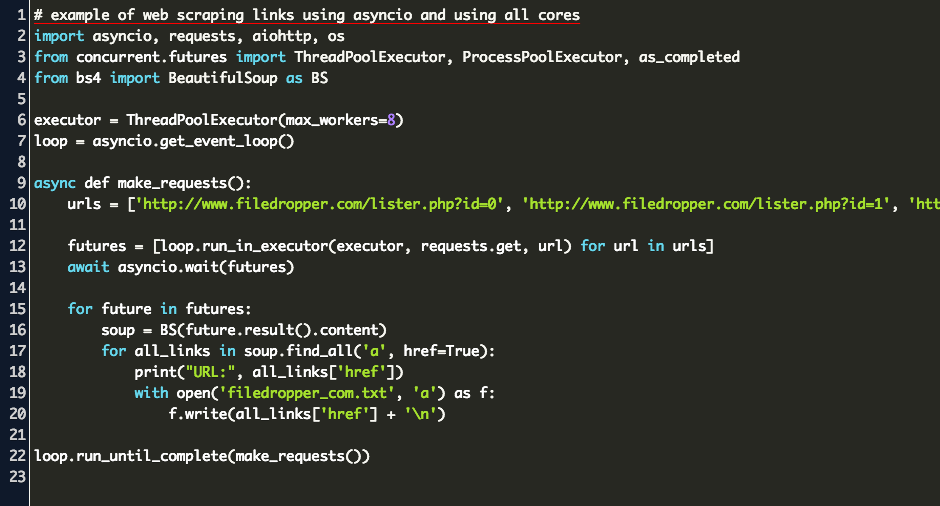Python 3, Web-scraping, and Javascript Oh My Ask Question Asked 8 years, 8 months ago. Active 8 years, 8 months ago. Viewed 5k times 4. I have come to the point of entering the melee on web-scraping webpages using Javascript, with Python3. I am well aware that my boot may be making contact with a dead horse, but I feel like drawing my six. The webbyte is a byte object returned by the server and the content type present in webpage is mostly utf-8. Therefore you need to decode webbyte using decode method. This solves complete problem while I was having trying to scrap from a website using PyCharm. P.S - I use python 3.4. Python Web Scraping Tutorial PDF Version Quick Guide Resources Job Search Discussion Web scraping, also called web data mining or web harvesting, is the process of constructing an agent which can extract, parse, download and organize useful information from the web automatically. The incredible amount of data on the Internet is a rich resource for any field of research or personal interest. To effectively harvest that data, you’ll need to become skilled at web scraping.The Python libraries requests and Beautiful Soup are powerful tools for the job. If you like to learn with hands-on examples and you have a basic understanding of Python and HTML, then this tutorial is.
Someone on the NICAR-L listserv asked for advice on the best Python libraries for web scraping. My advice below includes what I did for last spring’s Computational Journalism class, specifically, the Search-Script-Scrape project, which involved 101-web-scraping exercises in Python.
See the repo here: https://github.com/compjour/search-script-scrape
Best Python libraries for web scraping
For the remainder of this post, I assume you’re using Python 3.x, though the code examples will be virtually the same for 2.x. For my class last year, I had everyone install the Anaconda Python distribution, which comes with all the libraries needed to complete the Search-Script-Scrape exercises, including the ones mentioned specifically below:
The best package for general web requests, such as downloading a file or submitting a POST request to a form, is the simply-named requests library(“HTTP for Humans”).
Here’s an overly verbose example:
The requests library even does JSON parsing if you use it to fetch JSON files. Here’s an example with the Google Geocoding API:

For the parsing of HTML and XML, Beautiful Soup 4 seems to be the most frequently recommended. I never got around to using it because it was malfunctioning on my particular installation of Anaconda on OS X.

But I’ve found lxml to be perfectly fine. I believe both lxml and bs4 have similar capabilities – you can even specify lxml to be the parser for bs4. I think bs4 might have a friendlier syntax, but again, I don’t know, as I’ve gotten by with lxml just fine:
The standard urllib package also has a lot of useful utilities – I frequently use the methods from urllib.parse. Python 2 also has urllib but the methods are arranged differently.
Here’s an example of using the urljoin method to resolve the relative links on the California state data for high school test scores. The use of os.path.basename is simply for saving the each spreadsheet to your local hard drive:
And that’s about all you need for the majority of web-scraping work – at least the part that involves reading HTML and downloading files.

Examples of sites to scrape
The 101 scraping exercises didn’t go so great, as I didn’t give enough specifics about what the exact answers should be (e.g. round the numbers? Use complete sentences?) or even where the data files actually were – as it so happens, not everyone Googles things the same way I do. And I should’ve made them do it on a weekly basis, rather than waiting till the end of the quarter to try to cram them in before finals week.
The Github repo lists each exercise with the solution code, the relevant URL, and the number of lines in the solution code.
The exercises run the gamut of simple parsing of static HTML, to inspecting AJAX-heavy sites in which knowledge of the network panel is required to discover the JSON files to grab. In many of these exercises, the HTML-parsing is the trivial part – just a few lines to parse the HTML to dynamically find the URL for the zip or Excel file to download (via requests)…and then 40 to 50 lines of unzipping/reading/filtering to get the answer. That part is beyond what typically considered “web-scraping” and falls more into “data wrangling”.
In this tutorial video for beginners, learn how to create and use OneNote Class Notebook in Microsoft Teams.Watch all of my videos on Microsoft Teams: https. Unlike the Teams view of OneNote, the full desktop application of OneNote gives you maximum capabilities with the program, including some of the features we are going to look at next. Additionally, many people tell me that they prefer the desktop version. The good news is, you can open a Team notebook in OneNote desktop application. Microsoft Teams To add a new or existing OneNote notebook to a channel in Microsoft Teams, select Add a tab at the top of the channel and select OneNote. From there, choose an option: To start from scratch, select Create a new notebook, add a name to the Notebook name field, and click Save. Teams and onenote. Meeting notes are a great place to capture and share notes before, during, and after a Teams meeting. A few things to keep in mind: Only people in the same org as the meeting organizer will be able to start or access meeting notes. Meeting notes are available in meetings with up to 100 people.

I didn’t sort the exercises on the list by difficulty, and many of the solutions are not particulary great code. Sometimes I wrote the solution as if I were teaching it to a beginner. But other times I solved the problem using the style in the most randomly bizarre way relative to how I would normally solve it – hey, writing 100+ scrapers gets boring.
But here are a few representative exercises with some explanation:
1. Number of datasets currently listed on data.gov
I think data.gov actually has an API, but this script relies on finding the easiest tag to grab from the front page and extracting the text, i.e. the 186,569 from the text string, '186,569 datasets found'. This is obviously not a very robust script, as it will break when data.gov is redesigned. But it serves as a quick and easy HTML-parsing example. Hp officejet pro 8600 premium software download mac.
29. Number of days until Texas’s next scheduled execution
Texas’s death penalty site is probably one of the best places to practice web scraping, as the HTML is pretty straightforward on the main landing pages (there are several, for scheduled and past executions, and current inmate roster), which have enough interesting tabular data to collect. But you can make it more complex by traversing the links to collect inmate data, mugshots, and final words. This script just finds the first person on the scheduled list and does some math to print the number of days until the execution (I probably made the datetime handling more convoluted than it needs to be in the provided solution)
3. The number of people who visited a U.S. government website using Internet Explorer 6.0 in the last 90 days
The analytics.usa.gov site is a great place to practice AJAX-data scraping. It’s a very simple and robust site, but either you are aware of AJAX and know how to use the network panel (and in this case, locate ie.json, or you will have no clue how to scrape even a single number on this webpage. I think the difference between static HTML and AJAX sites is one of the tougher things to teach novices. But they pretty much have to learn the difference given how many of today’s websites use both static and dynamically-rendered pages.
6. From 2010 to 2013, the change in median cost of health, dental, and vision coverage for California city employees
There’s actually no HTML parsing if you assume the URLs for the data files can be hard coded. So besides the nominal use of the requests library, this ends up being a data-wrangling exercise: download two specific zip files, unzip them, read the CSV files, filter the dictionaries, then do some math.
90. The currently serving U.S. congressmember with the most Twitter followers
Another example with no HTML parsing, but probably the most complicated example. You have to download and parse Sunlight Foundation’s CSV of Congressmember data to get all the Twitter usernames. Then authenticate with Twitter’s API, then perform mulitple batch lookups to get the data for all 500+ of the Congressional Twitter usernames. Then join the sorted result with the actual Congressmember identity. I probably shouldn’t have assigned this one.

HTML is not necessary
I included no-HTML exercises because there are plenty of data programming exercises that don’t have to deal with the specific nitty-gritty of the Web, such as understanding HTTP and/or HTML. It’s not just that a lot of public data has moved to JSON (e.g. the FEC API) – but that much of the best public data is found in bulk CSV and database files. These files can be programmatically fetched with simple usage of the requests library.
It’s not that parsing HTML isn’t a whole boatload of fun – and being able to do so is a useful skill if you want to build websites. But I believe novices have more than enough to learn from in sorting/filtering dictionaries and lists without worrying about learning how a website works.
Besides analytics.usa.gov, the data.usajobs.gov API, which lists federal job openings, is a great one to explore, because its data structure is simple and the site is robust. Here’s a Python exercise with the USAJobs API; and here’s one in Bash.
Web Scraping With Python Pdf
There’s also the Google Maps geocoding API, which can be hit up for a bit before you run into rate limits, and you get the bonus of teaching geocoding concepts. The NYTimes API requires creating an account, but you not only get good APIs for some political data, but for content data (i.e. articles, bestselling books) that is interesting fodder for journalism-related analysis.
Python 3 Web Scraping Selenium
But if you want to scrape HTML, then the Texas death penalty pages are the way to go, because of the simplicity of the HTML and the numerous ways you can traverse the pages and collect interesting data points. Besides the previously mentioned Texas Python scraping exercise, here’s one for Florida’s list of executions. And here’s a Bash exercise that scrapes data from Texas, Florida, and California and does a simple demographic analysis.
Python Screen Scraping Tutorial
Citrix and microsoft teams. If you want more interesting public datasets – most of which require only a minimal of HTML-parsing to fetch – check out the list I talked about in last week’s info session on Stanford’s Computational Journalism Lab.
